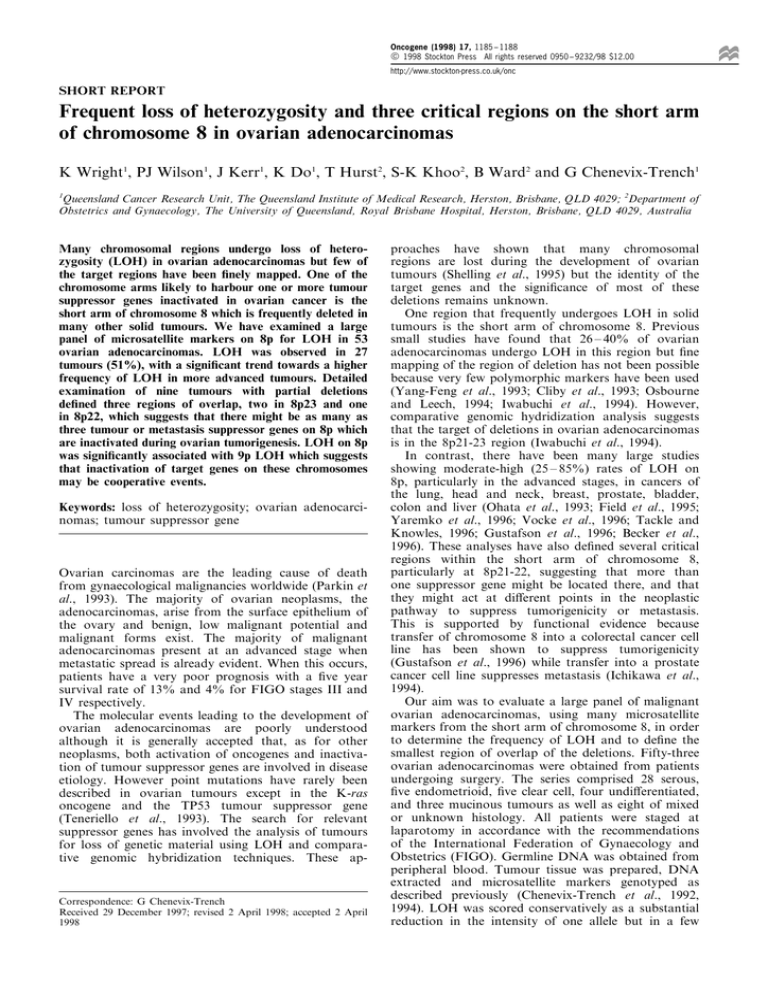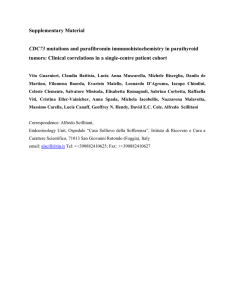Frequent loss of heterozygosity and three critical regions on
advertisement

Oncogene (1998) 17, 1185 ± 1188 1998 Stockton Press All rights reserved 0950 ± 9232/98 $12.00 http://www.stockton-press.co.uk/onc SHORT REPORT Frequent loss of heterozygosity and three critical regions on the short arm of chromosome 8 in ovarian adenocarcinomas K Wright1, PJ Wilson1, J Kerr1, K Do1, T Hurst2, S-K Khoo2, B Ward2 and G Chenevix-Trench1 1 Queensland Cancer Research Unit, The Queensland Institute of Medical Research, Herston, Brisbane, QLD 4029; 2Department of Obstetrics and Gynaecology, The University of Queensland, Royal Brisbane Hospital, Herston, Brisbane, QLD 4029, Australia Many chromosomal regions undergo loss of heterozygosity (LOH) in ovarian adenocarcinomas but few of the target regions have been ®nely mapped. One of the chromosome arms likely to harbour one or more tumour suppressor genes inactivated in ovarian cancer is the short arm of chromosome 8 which is frequently deleted in many other solid tumours. We have examined a large panel of microsatellite markers on 8p for LOH in 53 ovarian adenocarcinomas. LOH was observed in 27 tumours (51%), with a signi®cant trend towards a higher frequency of LOH in more advanced tumours. Detailed examination of nine tumours with partial deletions de®ned three regions of overlap, two in 8p23 and one in 8p22, which suggests that there might be as many as three tumour or metastasis suppressor genes on 8p which are inactivated during ovarian tumorigenesis. LOH on 8p was signi®cantly associated with 9p LOH which suggests that inactivation of target genes on these chromosomes may be cooperative events. Keywords: loss of heterozygosity; ovarian adenocarcinomas; tumour suppressor gene Ovarian carcinomas are the leading cause of death from gynaecological malignancies worldwide (Parkin et al., 1993). The majority of ovarian neoplasms, the adenocarcinomas, arise from the surface epithelium of the ovary and benign, low malignant potential and malignant forms exist. The majority of malignant adenocarcinomas present at an advanced stage when metastatic spread is already evident. When this occurs, patients have a very poor prognosis with a ®ve year survival rate of 13% and 4% for FIGO stages III and IV respectively. The molecular events leading to the development of ovarian adenocarcinomas are poorly understood although it is generally accepted that, as for other neoplasms, both activation of oncogenes and inactivation of tumour suppressor genes are involved in disease etiology. However point mutations have rarely been described in ovarian tumours except in the K-ras oncogene and the TP53 tumour suppressor gene (Teneriello et al., 1993). The search for relevant suppressor genes has involved the analysis of tumours for loss of genetic material using LOH and comparative genomic hybridization techniques. These ap- Correspondence: G Chenevix-Trench Received 29 December 1997; revised 2 April 1998; accepted 2 April 1998 proaches have shown that many chromosomal regions are lost during the development of ovarian tumours (Shelling et al., 1995) but the identity of the target genes and the signi®cance of most of these deletions remains unknown. One region that frequently undergoes LOH in solid tumours is the short arm of chromosome 8. Previous small studies have found that 26 ± 40% of ovarian adenocarcinomas undergo LOH in this region but ®ne mapping of the region of deletion has not been possible because very few polymorphic markers have been used (Yang-Feng et al., 1993; Cliby et al., 1993; Osbourne and Leech, 1994; Iwabuchi et al., 1994). However, comparative genomic hydridization analysis suggests that the target of deletions in ovarian adenocarcinomas is in the 8p21-23 region (Iwabuchi et al., 1994). In contrast, there have been many large studies showing moderate-high (25 ± 85%) rates of LOH on 8p, particularly in the advanced stages, in cancers of the lung, head and neck, breast, prostate, bladder, colon and liver (Ohata et al., 1993; Field et al., 1995; Yaremko et al., 1996; Vocke et al., 1996; Tackle and Knowles, 1996; Gustafson et al., 1996; Becker et al., 1996). These analyses have also de®ned several critical regions within the short arm of chromosome 8, particularly at 8p21-22, suggesting that more than one suppressor gene might be located there, and that they might act at dierent points in the neoplastic pathway to suppress tumorigenicity or metastasis. This is supported by functional evidence because transfer of chromosome 8 into a colorectal cancer cell line has been shown to suppress tumorigenicity (Gustafson et al., 1996) while transfer into a prostate cancer cell line suppresses metastasis (Ichikawa et al., 1994). Our aim was to evaluate a large panel of malignant ovarian adenocarcinomas, using many microsatellite markers from the short arm of chromosome 8, in order to determine the frequency of LOH and to de®ne the smallest region of overlap of the deletions. Fifty-three ovarian adenocarcinomas were obtained from patients undergoing surgery. The series comprised 28 serous, ®ve endometrioid, ®ve clear cell, four undierentiated, and three mucinous tumours as well as eight of mixed or unknown histology. All patients were staged at laparotomy in accordance with the recommendations of the International Federation of Gynaecology and Obstetrics (FIGO). Germline DNA was obtained from peripheral blood. Tumour tissue was prepared, DNA extracted and microsatellite markers genotyped as described previously (Chenevix-Trench et al., 1992, 1994). LOH was scored conservatively as a substantial reduction in the intensity of one allele but in a few LOH on the short arm of chromosome 8 in ovarian adenocarcinomas K Wright et al 1186 cases scoring was impossible because of the proximity of the two alleles and the presence of shadow bands so in these cases no score was given with respect to LOH. Eight microsatellite markers, distributed over the short arm of chromosome 8, were used initially. All 53 cases were informative for at least one marker and 27/53 (51%) showed LOH at one or more informative loci. The LOH rates were 7/29 (24.0%) at ANK1, 12/31 (38.7%) at D8S87, 13/36 (36.1%) at D8S136, 13/28 (46.4%) at LPL, 13/30 (43.3%) at D8S254, 18/33 (54.6%) at D8S1827, 13/30 (43.3%) at D8S550 and 14/28 (50.0%) at D8S264. The highest rates were therefore at D8S264, D8S550 and D8S1827 which are located at 8p22-23, while the lowest were at D8S87 and ANK1 at 8p11-12. In 16/27 (59.3%) of the tumours with LOH, all the informative loci showed LOH indicating that the whole chromosome arm had probably been lost. The remaining 11 tumours showed LOH at some but not all informative markers. In nine of the tumours for which sucient DNA was available, a further eight markers located at 8p22-23 (D8S439, D8S1759, D8S1130, D8S511, D8S549, AFM333TH1, D8S1754 and D8S261) were used to de®ne three smallest regions of overlap of the deletions (Figures 1 and 2). This analysis indicated that there might be as many as three target regions harbouring suppressor genes on 8p ± distal to D8S1759 at 8p23, around D8S549 at 8p23 and around LPL at 8p22. LOH on 8p was observed in no (0/7) stage I tumours but in 33% (2/6), 61% (20/33) and 71% (5/7) tumours of stage II, III and IV respectively. This trend of increased rates of LOH with advancing stage was signi®cant (P=0.014; Mantel ± Haentzel test for trend). In contrast there was no association with grade (P=0.11; Mantel ± Haentzel test) or histological subtype of the tumour (P=0.47; Fisher's Exact test). 8p LOH was observed in 15/28 serous, 3/5 endometrioid, 2/5 clear cell, 0/3 mucinous, and 7/12 tumours of undierentiated, mixed or unknown histology. Since LOH analysis has been performed at many other loci in these tumours (Chenevix-Trench et al., 1997) we also analysed the data for associations between LOH on 8p and other chromosomal arms. LOH on 8p was signi®cantly associated with LOH on 9p (P=0.0005; Fisher's Exact test) and on chromosome 18 (P=0.001) even when the Bonferroni correction was used (P50.003). When the associations were strati®ed for stage, only the relationship between 8p and 9p remained signi®cant (P=0.026; Mantel ± Haentzel Figure 1 Loss of heterozygosity at 16 loci on the short arm of chromosome 8 in nine tumours with partial deletions. The three smallest regions of overlap, which include the loci D8S550-D8S264, D8S549 and LPL, are indicated. Black box ± LOH; Clear box ± no LOH; Grey box ± not informative LOH on the short arm of chromosome 8 in ovarian adenocarcinomas K Wright et al Figure 2 Loss of heterozygosity analyses in selected tumours which de®ne the smallest regions of overlap. Deleted alleles are noted with an arrowhead. G ± germline, T ± tumour test) which indicates that this association is independent of tumour progression. Survival analysis was also carried out for the 51 patients for whom follow up data was available. Using the Cox Proportional Hazard Model there was no signi®cant eect on survival for patients having LOH on 8p only, on 9p only or on both 8p and 9p, but survival was related to stage (P=0.009). In summary, LOH on the short arm of chromosome 8 is a frequent event in ovarian adenocarcinomas, occurring in our series more often than on any other chromosomal arm except 1p, 5q, 6q, 9p, 17p, 17q or 18q (Chenevix-Trench et al., 1997). LOH on 8p is signi®cantly associated with LOH on 9p suggesting that inactivation of the target genes on these chromosomes may be cooperative events. Fine deletion mapping suggests that there might be as many as three suppressor genes in 8p22-23 inactivated in ovarian cancer. However these data should be interpreted with caution until independently confirmed since the regions are de®ned by LOH in only a few tumours which had partial deletions and some of these may represent random events. Regions of 8p22-23 have been implicated by LOH analysis as harbouring suppressor genes relevant to the progression of many other tumour types (Suzuki et al., 1995; Yaremko et al., 1995; Bova et al., 1996). Whether these are all independent targets, or whether there are common targets inactivated in a wide variety of tumours will not be known until the relevant genes have been cloned. There is already some functional evidence from monochromosome transfer experiments to suggest that both tumour and metastasis suppressor genes exist on the short arm of chromosome 8. LOH on 8p occurs more frequently in ovarian tumours of advanced stage which might indicate that a metastasis suppressor gene is involved. However this might not be the case. The same trend with advanced stage is found in colorectal tumours but transfer of chromosome 8 into the SW620 cell line still suppresses tumorigenicity in athymic mice (Gustafson et al., 1996). Despite some extensive research aimed at identifying these putative suppressor genes which has been particularly aimed at characterizing a region homozygously deleted in a metastatic prostate cancer (Bova et al., 1996), the identity of these genes is currently unknown. Acknowledgements This work was supported by the National Health and Medical Research Council of Australia and the Queensland Cancer Fund. References Becker SA, Zhou Y-Z and Slagle BL. (1996). Cancer Res., 56, 5092 ± 5097. Bova GS, MacGrogan D, Levy A, Pin SS, Bookstein R and Isaacs WB. (1996). Genomics, 35, 46 ± 54. Chenevix-Trench G, Leary J, Kerr J, Michel J, Keord R, Hurst T, Parsons PG, Friedlander M and Khoo S-K. (1992). Oncogene, 7, 1059 ± 1065. Chenevix-Trench G, Kerr J, Friedlander M, Hurst T, Sanderson B, Coglan M, Ward B, Leary J and Khoo SK. (1994). Am. J. Hum. Genet., 55, 1433 ± 1449. Chenevix-Trench G, Kerr J, Hurst T, Shih Y-C, Purdie D, Bergman L, Friedlander M, Sanderson B, Zournazi A, Coombs T, Leary JA, Crawford E, Shelling AN, Cooke I, Ganesan TS, Searle J, Choi C, Barrett JC, Khoo S-K and Ward B. (1997). Gene. Chr. Cancer, 18, 75 ± 83. Cliby W, Ritland S, Hartmann L, Dodson M, Halling KC, Keeney G, Podratz KC and Jenkins RB. (1993). Cancer Res., 53, 2393 ± 2398. Field J, Kiaris H, Risk J, Tsiriyotis C, Adamson R, Zoumpourlis V, Rowley H, Taylor K, Whittaker J, Howard P, Beirne J, Gosney J, Woolgar J, Vaughan E, Spandidos D and Jones A. (1995). Br. J. Cancer, 72, 1180 ± 1188. Gustafson CE, Wilson PJ, Lukeis R, Baker E, Woolatt E, Annab L, Hawke L, Barrett JC and Chenevix-Trench G. (1996). Cancer Res., 56, 5238 ± 5245. Ichikawa T, Nehei I, Suzuki H, Oshimura M, Emi M, Nakamura Y, Hayata I, Isaacs JT and Shimazaki J. (1994). Cancer Res., 54, 2299 ± 2302. 1187 LOH on the short arm of chromosome 8 in ovarian adenocarcinomas K Wright et al 1188 Iwabuchi T, Sakamoto M, Sakunaga H, May Y-Y, Carcangio ML, Pinkel D, Yang-Feng TL and Gray JW. (1994). Cancer Res., 55, 6172 ± 6180. Ohata H, Emi M, Fujiwara Y, Higashino K, Nakagawa K, Futagami R, Tsuchiya E and Nakamura Y. (1993). Gene. Chr. Cancer, 7, 85 ± 88. Osbourne RJ and Leech V. (1994). Br. J. Cancer, 69, 429 ± 438. Parkin DM, Pisani P and Ferlay J. (1993). Int. J. Cancer, 54, 594 ± 606. Shelling AN, Cooke IE and Ganesan T. (1995). Br. J. Cancer, 72, 521 ± 527. Suzuki H, Emi M, Komiya A, Fujiwara Y, Yatani R, Nakamura Y and Shimazaki J. (1995). Gene. Chr. Cancer, 13, 168 ± 174. Tackle LA and Knowles MA. (1996). Oncogene, 12, 1083 ± 1087. Teneriello MG, Ebina M, Linnoila RI, Henry M, Nash JD, Park RC and Birrer MJ. (1993). Cancer Res., 53, 3103 ± 3108. Vocke CD, Pozzatti RO, Bostwick DG, Florencee CD, Jennings SB, Strup SE, Duray PH, Liotta LA, EmmertBuck MR and Linehan WM. (1996). Cancer Res., 56, 2411 ± 2416. Yang-Feng TL, Han H, Chen K-C, Li S, Claus EB, Carcangio ML, Chambers SK and Schwartz PE. (1993). Int. J. Cancer 54, 546 ± 551. Yaremko M, Recant WM and Westbrook CA. (1995). Gene. Chr. Cancer, 13, 186 ± 191. Yaremko M, Kutza C, Lyzak J, Mick R, Recant W and Westbrook C. (1996). Gene. Chr. Cancer, 16, 189 ± 195.



